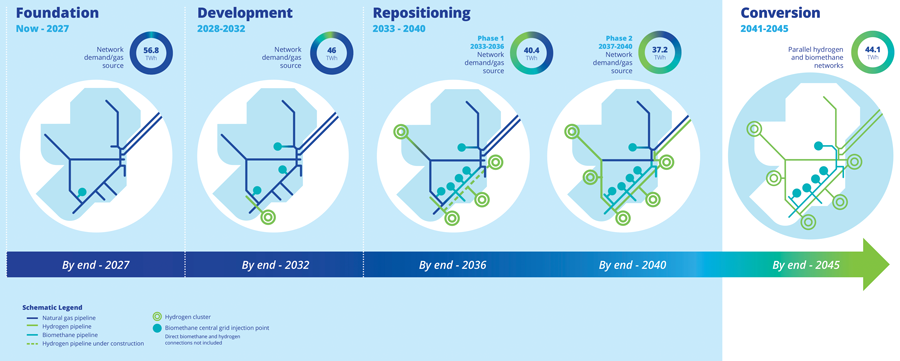Gas Networks Ireland’s David Kelly: Ireland’s future with renewable gas

As Ireland accelerates its journey toward a decarbonised energy system, the transformation of the national gas network plays a critical role in delivering a cleaner, more secure energy future. David Kelly, Director of Customer and Business Development at Gas Networks Ireland, discusses the utility’s vision to repurpose and decarbonise the country’s €3 billion gas network infrastructure using renewable gases, biomethane, and green hydrogen.
Q: David, you have recently been appointed Vice President of Dublin Chamber for 2025. Congratulations. How does your new role align with your work at Gas Networks Ireland?
Thank you. I am honoured to take on the role with Dublin Chamber and to support the business community through this important platform. There is a clear synergy between my role at the Chamber and my work at Gas Networks Ireland — both focus on long-term economic sustainability, innovation and supporting Irish enterprise through change. At Gas Networks Ireland, we are working on one of the biggest transformations in the history of Ireland’s energy infrastructure: transitioning the gas network to carry 100 per cent renewable gas by 2045. That ambition goes hand-in-hand with the need to support businesses as they adapt and decarbonise.
Q: Let us start with that vision — what is the Pathway to a Net Zero Carbon Network?
The pathway is our strategic roadmap to fully decarbonise Ireland’s national gas network by 2045. Right now, over 99 per cent of the gas in the network is natural gas. By 2045 we plan to replace that entirely with renewable gases; a third will be biomethane and two thirds will be green hydrogen. That means repurposing existing infrastructure and ensuring that that the national network is capable of safely and efficiently transporting renewable gases. It is a bold but achievable vision, and one that is essential to Ireland achieving its national climate targets while maintaining energy security.
Q: Why is renewable gas so important to Ireland’s energy transition?
Renewable gases – especially biomethane and green hydrogen – have unique advantages. Biomethane is a carbon neutral gas produced from organic waste and is already being injected into the gas network with little or no changes required to existing infrastructure. It is available today and can immediately displace natural gas in heating, transport and industry. Green hydrogen made from wind and solar on the other hand is a longer-term solution that will play a central role in decarbonising sectors that are hard to electrify, like heavy industry and high temperature manufacturing.
The gas network also provides critical backup for Ireland’s electricity grid, especially during periods of low wind generation. In 2024, gas generated a total of 41 per cent of electricity used in the country, reaching up to 83 per cent of our electricity needs at times of peak demand and low wind energy generation. Replacing natural gas with renewable gas in that role means we can deliver clean, secure, and flexible energy for all customers – something that is essential for a net zero future.
Q: Biomethane seems to be the immediate opportunity. What progress has Gas Networks Ireland made in this space?
We have made great strides in the last few years. Gas Networks Ireland’s new Central Grid Injection (CGI) facility in Mitchelstown represents a key step in supporting Ireland’s transition to renewable energy. This €32 million investment will enable the injection of biomethane into the national gas network, providing an essential connection point for producers located remotely from existing gas infrastructure.
Once fully operational, the facility is expected to reduce Ireland’s CO2 emissions by approximately 130,000 tonnes annually. Biomethane injected through the Mitchelstown CGI will contribute around 12 per cent of the Government’s 2030 target of 5.7 TWh. Market interest remains very strong, with estimated biomethane volumes from 22 interested producers exceeding the CGI’s total capacity by more than two and a half times. Commissioning of the first phase is expected in early 2026.
We have also signed a significant gas network connection agreement with Bia Energy, who are building a €60 million anaerobic digestion plant in Huntstown. Once operational, the plant will inject large volumes of biomethane directly into the national network.
There is strong market appetite as well. We received 176 expressions of interest from potential biomethane producers in response to a recent national Request for Information process – almost triple the current 2030 target. Ireland has the highest per capita biomethane potential in Europe, and we are working to unlock that. It is not just about emissions reduction, biomethane has huge potential to support the rural economy potentially creating new income streams for farmers and supports circular agriculture.
Q: How is Gas Networks Ireland enabling the growth of Ireland’s biomethane sector?
Gas Networks Ireland is facilitating connections to the gas network and constructing its first central grid injection point in County Cork for those renewable gas producers that are not located close the gas network. We are working closely with developers, customers, and policymakers. Our role is also about de-risking the market and creating confidence that renewable gas projects can connect, sell their output, and operate sustainably over the long term.
Q: What are you hearing from biomethane developers and customers on the ground?
There is definitely appetite in the market, but there are also some headwinds. Developers are working hard to progress projects, but until the Government’s Renewable Heat Obligation (RHO) is published and challenges with the planning system are overcome, we will see some investor uncertainty.
Customers, particularly in the agri-food and industrial sectors, are telling us they want to move to renewable gas, but they need confidence around policy, infrastructure and project timelines.
That is why our focus is not just on connections and capacity, but on helping to unlock projects and build investor and customer trust in the sector.

Q: Are there recent developments or partnerships you are particularly excited about?
Yes, as well as announcements from CycleØ, Bia Energy, and Nephin Renewables, we are seeing new market entrants come forward, such as Greengate Biogas, which has announced plans to develop a 250 GWh anaerobic digestion plant in Carlow. They are actively engaging with the local community and have hosted a public information event. These kinds of projects demonstrate both ambition and a real commitment to collaboration—something that is essential to success in this space.
Q: Large energy users (LEUs) are increasingly being linked to renewable gas. What is the significance of this trend for the development of biomethane in Ireland?
We are seeing large energy users expressing an interest in renewable gas as a decarbonised energy solution and signing long-term gas purchase agreements with anaerobic digestion (AD) developers, which is helping to underpin the commercial viability of new biomethane projects.
The National Biomethane Strategy identifies industry investment as one of the three core pillars—alongside capital grants and the RHO—to put Ireland on a trajectory to meet its 5.7 TWh biomethane target by 2030. What we are seeing now is industry stepping up with LEUs playing a key role. Their early commitment sends a strong signal to the market.
Q: Green hydrogen is a longer-term ambition. What is Gas Networks Ireland doing to prepare for it?
Hydrogen is absolutely critical to achieving net zero. But producing it at scale in Ireland will require a significant buildout of offshore wind to power electrolysers. That will take time but we are getting ahead of the curve by ensuring our network is hydrogen ready now.
We are already conducting green hydrogen trials, including a successful project at Daltons Chancellors Mills in Athy, where a local family business is taking advantage of its connection to the gas network to blend green hydrogen to power their industrial processes, which is working seamlessly.
We are also investing in hydrogen research working with UCD and other partners and preparing our interconnectors with Britain for future hydrogen imports. Britain is likely to begin blending hydrogen into its network in the next few years and we need to be ready for that.

Q: What is the role of hydrogen clusters in your strategy?
Clusters are a smart way to build out the hydrogen economy incrementally. These are regions where hydrogen production, use and storage are all co located, typically around large industrial users. Our first major project in that regard is the Celtic Hydrogen Cluster in east Cork. It leverages existing infrastructure and industrial demand and is a blueprint for other clusters around the country.
Over time we will connect these clusters into a national hydrogen backbone, which could then integrate with the European Hydrogen Backbone, allowing for international trade and energy resilience.
Q: How is Gas Networks Ireland supporting industrial customers during this transition?
We are very focused on partnership and innovation. Many businesses want to decarbonise but need help figuring out how. We have established a dedicated Customer Solutions team to provide a key support to our largest customers. This team provides proactive, regular, collaborative engagement, to inform and empower large customers to facilitate their transition to renewable gas solutions.
For biomethane, we are working closely with energy suppliers, energy traders and the wider energy ecosystem to ensure there is a clear and simple pathway for large customers to procure renewable gases. Through our Innovation Fund, we co-fund projects that trial renewable gas solutions for high heat customers. We have also published a Hydrogen Technical Guide to help industrial customers assess their compatibility with hydrogen.
Q: How does this all tie into energy security?
A decarbonised gas network does not just support climate goals, it also strengthens our energy independence. By using indigenous biomethane and producing green hydrogen from Irish wind and solar, we will reduce our reliance on fossil fuel imports. Our gas network is also a strategic asset valued at €3 billion, it provides vital energy backup and system flexibility.
In 2024 when wind generation dropped, gas generated up to 83 per cent of Ireland’s electricity needs. By replacing that gas with renewable alternatives we are ensuring both security and sustainability.
Q: Looking ahead to 2045 — what does success look like for Gas Networks Ireland?
Success is a fully decarbonised gas network that enables Ireland to meet its climate targets, supports economic growth and provides clean, secure energy for homes and businesses. It is a network that carries 100 per cent renewable gas — split between biomethane and hydrogen — and integrates seamlessly with electricity and transport systems.
It also means Ireland is recognised as a European leader in renewable gas, with strong domestic supply, export capability and thriving rural and industrial economies built on clean energy.
The energy transition is a once-in-a-generation challenge, and opportunity. At Gas Networks Ireland we are proud to be doing our part. Our team is passionate about delivering practical, scalable solutions that work for Ireland. The future is renewable — and it is already underway.
|
Gas Networks Ireland’s Pathway to a Net Zero Carbon Network is structured into four key phases: 1. Foundation (to 2027): This phase is underway. The groundwork is being laid; injection points are being established, biomethane delivery is being enabled and the network is being prepared to safely accommodate renewable gases. A key milestone is the new Central Grid Injection (CGI) facility in Mitchelstown, County Cork, which will inject up to 700 GWh of biomethane per year. 2. Development (2028–2032): This phase will see scaling of operations. The aim is to meet the Government’s 5.7 TWh biomethane target and initiate hydrogen blending into the network. By the end of this period, renewable gases will account for 17 per cent of the network gas mix. 3. Repositioning (2033–2040): Large sections of the network will be repurposed, and hydrogen clusters will be deployed around key industrial hubs. By 2040, biomethane and hydrogen will together comprise over 80 per cent of the gas mix. 4. Conversion (2041–2045): The final transformation phase. Two parallel renewable gas networks will be operated: one for hydrogen and one for biomethane. Natural gas will be fully phased out by 2045. |
www.gasnetworks.ie







